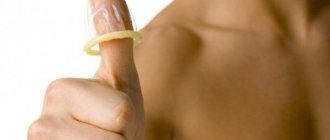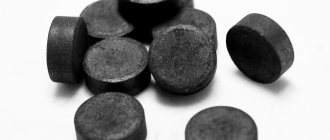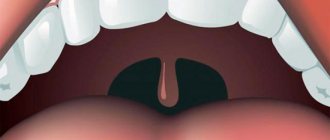Reasons for the development of pathology
In the vast majority of cases, a short frenulum is a consequence of a developmental abnormality and is combined with phimosis - a narrowing of the foreskin with the impossibility of exposing the head of the penis. According to statistics, up to 5% of uncircumcised men suffer from insufficient extensibility of the folds of skin on the penis. This anomaly is accompanied by a number of painful and unpleasant symptoms:
- curvature of the penis in an erect state;
- pain during sexual intercourse;
- premature ejaculation;
- the frenulum breaks as a result of active movements during intercourse.
With normal development, the frenulum is of sufficient length and can stretch significantly, providing comfortable and painless movement of the foreskin. A fold of skin that is too short causes a lot of trouble and can cause serious complications.
Possible triggers
Other possible causes of pathology are:
- Chronic inflammatory diseases of the penis
. Balanitis and balanoposthitis, in most cases occurring with the presence of pathogenic microflora, lead to structural tissue changes in the area of the head of the penis. - Chronic injuries to the foreskin
. Even microdamages to the delicate skin of the penis without proper and timely response can lead to improper tissue fusion. Such injuries occur when playing certain sports or wearing too tight underwear and clothes. - Diabetes mellitus in the stage of decompensation
. In this case, tissue changes are caused by a characteristic sign of the disease - a disruption of the regeneration process, as a result of which cicatricial deformities begin to appear in the tissues of the frenulum.
Most often, the pathology is diagnosed when a man begins to have an active sexual life. That's when the real problems begin. Especially if the disease is not detected and treated in time.
Causes of pathology in children
It is not possible to identify a pathological condition in a small child. The main symptoms appear only during puberty. Indirect indications of the presence of an anomaly are:
- Phimosis
. Although physiological phimosis is present in almost all newborns, by the 3rd year of life in 90% of boys the head opens completely. Only in 1-5% of children the pathology persists until adulthood - and, as a rule, is accompanied by a short frenulum. - Heredity
. Genetic factors influence the transmission to subsequent generations of most abnormal deviations, including those in the structure of organs and systems. If one of the parents has such a pathology in the family, there is a high probability that the anomaly will manifest itself in the child.
It is possible to detect the presence of a pathological condition of the frenulum of the penis in a boy only by indirect signs, since the child prefers to endure discomfort. However, if you regularly cry while urinating, a thorough examination of the penis is necessary. Possible signs of pathology are:
- redness or swelling in the foreskin area;
- the presence of phimosis - the inability to expose the head;
- the appearance of bloody discharge during water procedures;
- accumulation of smegma (preputial lubricant), causing pain and burning.
All these symptoms indicate the possible presence of pathology in the genitals. The presence of alarming signs requires mandatory medical consultation. And in case of diagnosing a pathology - timely treatment.
How to prepare for frenuloplasty
In the process of preparing for surgery, you should consult with a urologist, who will draw up a complete list of recommendations based on the individual characteristics of the patient and the results of the tests performed. A week before the planned procedure, it is necessary to avoid taking any aspirin and non-steroidal anti-inflammatory drugs.
On the day of surgery, you need to perform a number of simple steps:
- carry out a thorough toilet of the genitals and hygienic cleaning using special products for the care of the intimate area;
- shave the scrotal area;
- give up caffeine in the morning, and breakfast should be as light as possible, without fatty foods;
- Bring a set of sterile wipes and spare linen with you to the clinic.
If the patient is allergic to various drugs, you must inform your doctor about this, and take an antihistamine the day before frenuloplasty. In cases of a negative reaction of the body to general anesthesia, it is required to notify the anesthesiologist.
Compliance with all general recommendations for preparing for the correction procedure contributes to the most effective implementation of all surgical procedures with minimal risks of subsequent deviations.
Causes of pathology in adolescents
At the age of 13-18 years, rapid development of the genital organs occurs and the reproductive system is formed. This period is characterized by the possible occurrence of hormonal imbalances, as well as disruption of the normal functionality of certain systems and organs.
It is during puberty that there is a high probability of a discrepancy between the growth rate of skin tissue and the rapidly developing cavernous bodies in the penis.
As a result of the rapid onset of puberty, the frenulum of the penis becomes short in comparison with the size of the organ itself and is unable to painlessly perform its functions - to help the foreskin cover the glans.
If a teenager in this state begins to have sex (masturbation), there is a high probability that the skin fold will rupture or cracks will appear on it. Mini-damages of this kind must be treated with an antiseptic and consult a doctor.
Otherwise, not only mechanical damage, but also psycho-emotional discomfort may occur.
In the long term, this can lead to a decrease in confidence in one's sexual capabilities. And even cause impotence. During adolescence, not only puberty occurs, but also psychological foundations are formed. Therefore, the young person is especially vulnerable.
Methods of treating the pathological condition
Although a short frenulum is not an independent disease, such an anomaly requires qualified help and drug treatment. As a method of correcting the situation, traditional medicine offers exclusively surgical intervention.
It is emphasized that the earlier the pathology is identified, the less traumatic the treatment will be: the volume of surgical intervention in childhood is minimal, and the psyche adapts much better than in a mature man.
For adult men, the main sign by which an anomaly can be suspected is pain and discomfort of the penis during an erection.
In addition to a visual examination, the specialist conducts laboratory and hardware tests, after which he individually selects the most optimal type of surgical operation.
Frenulotomy or frenuloplasty
Dissection of the frenulum or frenulotomy is the most effective type of surgical intervention used in medical practice. Although it lasts no more than 20 minutes. and is performed under local anesthesia on an outpatient basis (for adolescents - with general anesthesia), requires full preparation for surgical intervention:
- blood and urine tests;
- passing tests for allergies to painkillers;
- additional blood tests (Rh factor, group, clotting rate).
2-3 days before surgical treatment, it is recommended to switch to a diet. It is necessary to stop drinking alcoholic beverages. Immediately before the operation, hair in the intimate area should be removed and careful hygiene should be carried out.
How is frenulotomy performed?
On the day of the operation, you need to come to the clinic in advance (about an hour) in loose outer clothing. The patient is asked to assume a supine position on the operating table. After that:
- the genital area is disinfected;
- local or general (injection into a vein) anesthesia is performed;
- the doctor makes a transverse incision on the frenulum, straightening the fold to the desired size;
- if there are scars, the surgeon excises them during the operation;
- the edges of the incisions are stitched with threads that dissolve during the rehabilitation process;
- the final stage is applying a napkin with an antiseptic (for at least 12 hours).
This is what the operation looks like using a regular scalpel. However, advances in technology have made it possible to expand the variability of frenuloplasty offerings. Clinics offer frenuloplasty using the following tools:
| Name | Advantages | Flaws |
| Laser | The advantage of this type of intervention is the absence of blood - the laser beam, when cut, instantly cauterizes the sutures | The only drawback is that the edges of the wound may separate when stretched in an erect state. |
| Radio knife | This technology is the safest from the point of view of the development of complications, since the effect is only on a narrowly targeted area without touching healthy tissues and blood vessels | The most expensive method available |
At the end of the medical procedures, the patient goes home, having first listened to the doctor’s recommendations. The hygienic bandage should be removed after 12-24 hours. A longer period (days) is preferable, but you should not leave the bandage on the wound too long.
Rehabilitation period
After this, it is necessary to carry out regular hygiene of the operated area and ensure that you do not develop new injuries or cracks in the skin of the penis:
- exclude increased physical activity;
- refuse sexual intercourse and masturbation;
- temporarily stop visiting baths and saunas.
The rehabilitation period lasts up to 3 weeks. This type of intervention has another important advantage - the cosmetic effect in this case is maximum. There are practically no scars or seams left.
When is VUplasty used?
The method is rarely used because it leaves noticeable scars on the penis that cannot be hidden by the foreskin. The surgeon makes a V-shaped incision in the frenulum, then sutures the edges in such a way as to increase the length of the fold.
In addition to cosmetic discomfort, this type of intervention can provoke phimosis, since after the operation there is a narrowing of the foreskin.
However, VU-plasty is performed in cases where other types of intervention are contraindicated.
But only after examination and doctor’s recommendation.
In what cases is circumcision recommended?
The cutting technique is similar to frenulotomy. The preparatory period, duration of the operation, anesthesia, and postoperative care are the same. The differences are as follows:
- Problem solving mechanism
. In this case, not only the frenulum is cut, but the entire fold of the foreskin is removed - the doctor leaves a small area of skin around the circumference (0.5-1 cm) so that there is no strong tension during an erection. - Duration of rehabilitation
. With circumcision, the recovery period is longer (up to 8 weeks), since a large area is injured.
The doctor recommends trimming the foreskin in cases where signs of phimosis are present. During one surgical procedure, a specialist can solve two problems at once: trim part of the skin fold, while simultaneously lengthening the frenulum. And forever rid a man of self-doubt.
Contraindications to surgical treatment
During preparation for surgery, a number of studies are required. However, the doctor may not be aware of any pathology in the patient. Therefore, it is necessary to familiarize yourself with the list of contraindications:
- diseases that cause decreased blood clotting;
- functional disorders in the liver and kidneys;
- oncology;
- injuries or ulcers in the operated area;
- inflammation of the MPS organs and STDs (sexually transmitted diseases).
The last contraindication is relative. It may be removed from the list after preliminary treatment.
Treatment of short frenulum of the penis
The only treatment for short frenulum is surgery. Surgery for a short frenulum (frenuloplasty or frenuloplasty) involves lengthening or excision of this skin fold. There are several options for frenuloplasty.
Classic frenuloplasty
It involves transverse intersection of the frenulum followed by suturing in the longitudinal direction. The advantage of this technique is its simplicity (the operation takes a few minutes).
Among the disadvantages of such plastic surgery, we can note the unevenness along the edges of the incision, formed from the remains of the dissected frenulum. Although the latter can be easily excised and leveled.
Z-plasty
Professor N.D. Akhvlediani proposed Z-shaped plastic surgery with the appropriate incision shape for the correction of premature ejaculation. This method is advantageous in the formation of a more mobile, elastic scar.
Complete excision of the frenulum
In some cases, especially when combined with circumcision, it is better to perform a complete excision of the frenulum, which permanently eliminates this hypersensitive area.
Laser and radio surgery
In recent years, new technologies such as laser or radiosurgery have begun to be used in frenuloplasty. More and more patients are seeking laser frenuloplasty. Indeed, a laser or radiosurgical knife allows frenuloplasty to be performed almost bloodlessly and very aesthetically.
Regardless of the option chosen, frenuloplasty is performed on an outpatient basis under local anesthesia. At the request of the patient, it is possible to perform this operation under anesthesia (during sleep).
For suturing, I use thin self-absorbable threads, which provides excellent cosmetic results and eliminates the need to remove sutures.
After surgery, a circular pressure bandage is usually applied, which protects the wound and reduces the risk of postoperative bleeding.
Wound healing after frenuloplasty takes about 10 days. Dressings are usually performed by the patient independently.
Restrictions after surgery relate only to sexual abstinence during the period of wound healing. There is no need to take sick leave or give up sports.
Non-surgical methods
Traditional medicine categorically denies the effectiveness of such techniques. However, if there are contraindications to surgical treatment, it is worth trying home methods for stretching the skin fold. There are several of them:
- The thumbs are carefully inserted into the prepuncial sac and begin to slightly stretch the skin. In this case, the feeling of discomfort should not develop into pain.
- Before the procedure, take a warm 15-minute shower or hot bath to soften the skin. Then the foreskin is retracted as much as possible and fixed for several minutes - this slightly stretches the frenulum and makes it more elastic.
Like any unconventional methods, such treatment will only work if used for a long time - more than 3 months minimum. The effectiveness will also depend on the individual characteristics of the organism. Such as age, physiology, regularity and correctness of execution.
Answers to pressing questions
Alexey, 24 years old: “Thank you for your information, a very useful article. But I had one question: is it possible to heal a torn frenulum with herbal decoctions?”
Answer: “Herbal infusions can be used as a way to relieve inflammatory processes and nothing more. There is no list of drugs or other folk remedies that allow you to get rid of the foreskin without surgery.”
Igor, 42 years old: “Relevant information for me, since I myself recently encountered a similar problem. Tell me, are there any other treatment methods besides the above?”
Answer: “To date, the five surgical treatment methods have shown to be positively effective. Although it is better to perform circumcision immediately, since this method has virtually no contraindications and relapses.”
What to do if the frenulum of the foreskin is torn?
As a result of careless movements or sudden entry into the vagina, injuries or tears in the skin fold are possible. If there is pain near the frenulum or there is a rupture, do not panic. The actions should be as follows:
- First of all, stop the bleeding. To do this, it is enough to press the gap with your fingers for at least 15 minutes. At the same time, try to fix only the damaged area, without completely pinching the vessels of the penis.
- The second step is treatment with an antiseptic. Hydrogen peroxide is most suitable, since alcohol can burn delicate skin.
- Seek advice from a specialist who will assess the extent of the damage and give recommendations on further actions.
In most cases, if the frenulum is torn, the doctor will refer you for surgery. Anyone who has torn it once may be injured in the future. And with consequences of varying complexity.
Rehabilitation after frenulotomy
After frenulotomy, the patient rests for several hours in the ward, then he is sent home. After 2-3 days you can go to work, if it does not involve lifting heavy loads (the seam may come apart).
There is usually some slight swelling or bruising in the first 24 hours, which goes away within a few hours. Within two days, a few drops of blood may come out of the suture. This is fine. They need to be blotted with a sterile napkin and observed over the wound.
Antibacterial therapy is usually not required. The course of antibiotics is replaced by antiseptic ointment "Levomekol". A thin layer of it is applied to the suture area once a day for 5 days. You must appear for a dressing change the next day, and for a final examination after 10 days. The pain goes away completely after 2 weeks. During an erection, slight discomfort may remain for 3-4 weeks.
During the rehabilitation period, the patient should adhere to the following recommendations of the attending physician:
- carry out hygiene measures after each visit to the toilet and use an antiseptic solution prescribed by a doctor for this;
- take a course of antibiotics to prevent the development of purulent infections;
- during rapid healing, do not use fat-based ointments, as they can prolong the rehabilitation period;
- visit a urologist a week after the operation so that he can determine the need to remove the remaining threads, which should be completely resolved by this time.
In addition, during the recovery period you should avoid:
- physical activity and sports;
- visits to baths, saunas, swimming pools;
- taking baths; sexual intercourse and masturbation.
- The latter is necessary in order to eliminate the risk of seams coming apart.
Why have surgery?
Some men live happily with a short frenulum all their lives because they do not experience discomfort. However, the appearance of pain, especially at an early age, is an alarming signal.
Indeed, in the future, discomfort during sex can become a trigger mechanism for the development of impotence. If the anomaly is acquired (due to balanoposthitis or other inflammatory diseases), then surgical treatment is the only way to avoid further injuries.
Methods of therapeutic treatment of the problem
Every male can experience a tear in the foreskin. It is for this reason that modern medicine offers several effective methods of therapeutic intervention on how to treat a torn frenulum on the head. Experts resort to:
- frenulotomy;
- circumcision;
- VY-plasty;
- laser surgical treatment;
- surgery based on radio waves.
The method of surgery depends on the degree of damage to the flesh.











